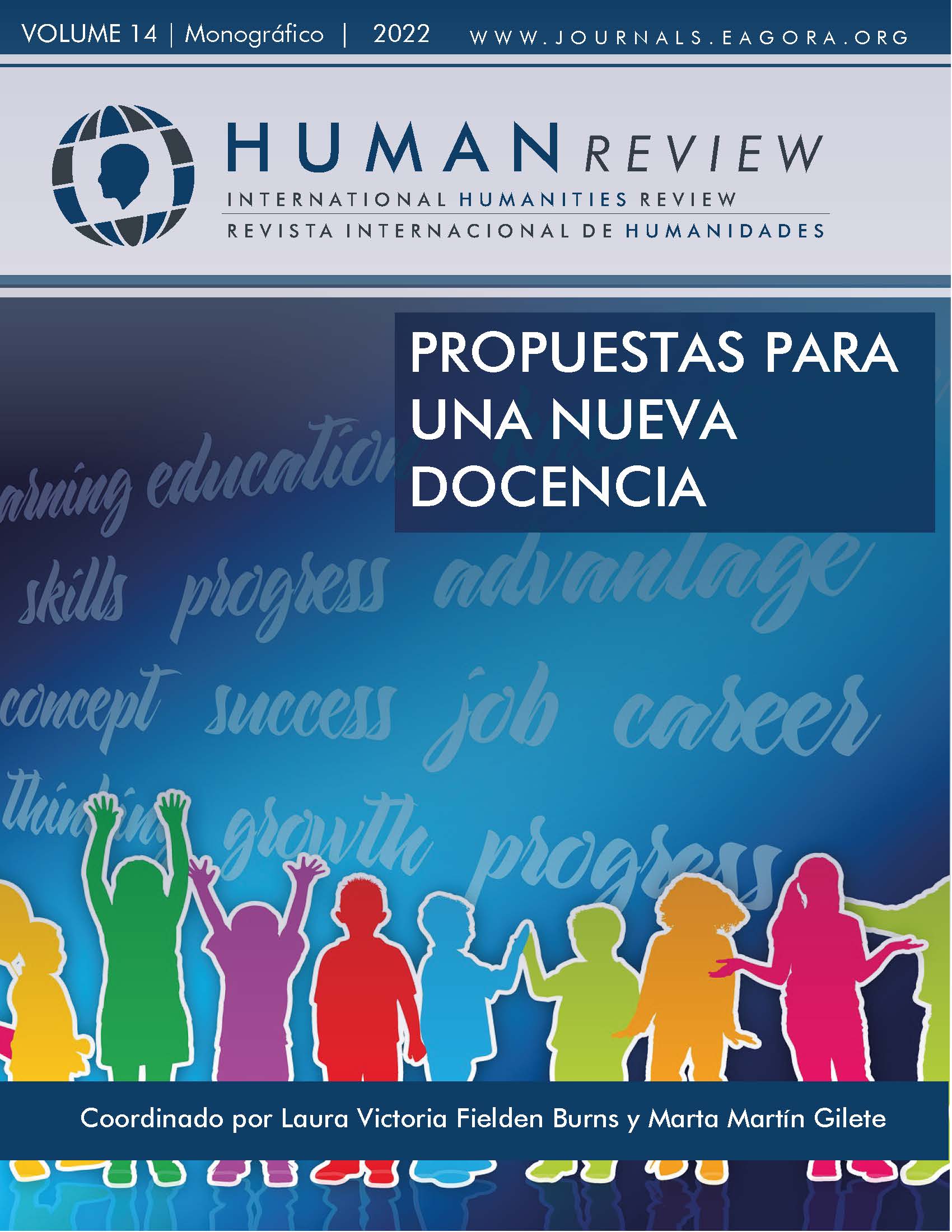Outdoor Higher Education
Reality at university
DOI:
https://doi.org/10.37467/revhuman.v11.4190Keywords:
Higher Education, Outdoor, Innovation, Teaching, Learning, Methodology, RealityAbstract
The current educational landscape requires the implementation of new teaching methodologies in the European Higher Education Area. The objective of this paper is to present a pilot study aimed at teaching outdoors as a way of recreating the real work that our students will develop in their professional future. In this respect, we intended to achieve significant learning as long as there is a real interaction with the learning objects. The result materialized in the positive evaluation by the students when they felt connected with their imminent job reality and the acquisition of interpersonal skills such as cooperation and camaraderie.
References
Anggard, E. (2010). Making use of “Nature” in an Outdoor Preschool: classroom, home and fairyland. Childen, Youth and Environments, 20(10), 4-25. https://www.jstor.org/stable/10.7721/chilyoutenvi.20.1.0004
Bruchner, P. (2012). Escuelas infantiles al aire libre. Cuadernos de Pedagogía, (420), 26-29. https://acortar.link/mL3uPB
Castañeda, A. (2017). El campismo como estrategia para la educación ambiental al aire libre en la Facultad de Ciencias y Educación de la Universidad Distrital “Francisco José de Caldas”. Trabajo Final de grado. Universidad Distrital Francisco José de Caldas. https://acortar.link/C8BqYL
Dahlgren, L., y Szczepanski, A. (2007). Outdoor Education. Literary education and sensory experience. Kisa. https://acortar.link/qp8Drd
Delgado, J., y Subires, P. (2016). Desarrollo de competencias geoespaciales en educación al aire libre: ejemplo de aplicación en Linköping (Suecia). La investigación e innovación en la enseñanza de la geografía. VII Congreso Ibérico de Didáctica de la Geografía. Universidad de Alicante. http://dx.doi.org/10.14198/GeoAlicante2015.38 DOI: https://doi.org/10.14198/GeoAlicante2015.38
Delors, J. (1996). La educación encierra un tesoro. UNESCO, 44. https://unesdoc.unesco.org/ark:/48223/pf0000109590_spa
Farias, D. (2005). El itinerario didáctico: Una propuesta metodológica para el análisis geo-histórico local. Geoenseñanza, 10(2), pp. 197-208. https://www.redalyc.org/pdf/360/36010206.pdf
Freire, H. (2011). Educar en verde: ideas para acercar a los niños y niñas a la naturaleza. Graó.
French L. (2004). Science as the center of a coherent, integrated early childhood curriculum. Early Childhood Research Quarterly, 19, 138–149. DOI: https://doi.org/10.1016/j.ecresq.2004.01.004
Galvis, M.J., Muñoz, D., Carmona, C., y Vazirani, S. (2020). Breakout educativo como herramienta innovadora en el grado de Criminología. Innovaciones metodológicas con TIC en educación. Pp. 982-1001. Dykinson. https://dialnet.unirioja.es/servlet/articulo?codigo=8039760
Gómez, I. (2016). Adquisición de competencias geoespaciales en la formación inicial del profesorado: el modelo Tpack y la educación al aire libre. Revista electrónica de recursos en Internet sobre geografía y ciencias sociales, 216(21), 1-18. https://revistes.ub.edu/index.php/aracne/article/view/26740
González, R. (2022). Marzo de 2020: el Covid 19 cambió nuestra forma de impatir las clases. Revista de la Asociación Española de Educación ambiental, 11, 4-6. https://ae-ea.es/wp-content/uploads/2022/02/V4-Revista-Educacion-Ambiental-2021_compressed.pdf#page=4
Gopnik, A. (2012). Scientific thinking in young children: Theoretical advances, empirical research, and policy implications. Science, 337(6102), 1623–1627. DOI: https://doi.org/10.1126/science.1223416
Greenfield, D. B. (2017). Unleashing the Power of Science in Early Childhood: A Foundation for High-Quality Interactions y Learning. Zero to Three, 37(5), 13–21.
Harum, M., y Salamuddin, N. (2010). Cultivating personality development through outdoor education programme: the Malaysia experience. Procedia Social and Behavioral Sciences, 9, 228-234. https://acortar.link/8fm5Z7 DOI: https://doi.org/10.1016/j.sbspro.2010.12.141
Hernández, M. (2013). Evaluación del programa de educación ambiental formal “aula al aire libre”, reserva los coyotes. Actualidades Investigativas en Educación, 13(2), 1-32. https://www.researchgate.net/publication/262719891_Evaluacion_del_programa_de_educacion_ambiental_formal_aula_al_aire_libre_Reserva_Los_Coyotes DOI: https://doi.org/10.15517/aie.v13i2.11729
Morales, F. (2002). Sobre el Emilio de Rousseau (Síntesis divulgativa). Acción Pedagógica, 11(1), 74-78. https://dialnet.unirioja.es/servlet/articulo?codigo=2973128
Moreno, J. (2021). La docencia al aire libre en educación secundaria. El currículo en el entorno. Edetania, 60, 209-228. https://doi.org/10.46583/edetania_2021.60.842 DOI: https://doi.org/10.46583/edetania_2021.60.842
Moreno-Martínez, N., Pardo, S., Hueso, G., y Vías, J. (2016). Aplicaciones de cartografía en línea desde una perspectiva colaborativa en la formación universitaria. En Gómez-Galán, López-Meneses y Cobos, La educación superior en el siglo XXI: El reto de las TIC. Volumen III.
Murillo, J., Arjones, A., Delgado, J., Hueso, P., y Ruiz, J. (2018). La educación al aire libre como herramienta para mejorar el aprendizaje del alumnado. XII Congreso de Didáctica de la Geografía, Madrid. https://hdl.handle.net/10630/16751
Olusda, A. (1996). Impact of an outdoor educational strategy on teacher profile in environmental education. International Journal of Educational Development, 16(3), 309-317. https://www.sciencedirect.com/science/article/abs/pii/0738059396000077?via%3Dihub DOI: https://doi.org/10.1016/0738-0593(96)00007-7
Parra-González, López, B., Segura-Robles, y Fuentes, C. (2020). Active and emerging methodologies for ubiquitous education: potential of flipped learning and gamification. Sustainability, 12, 1-11. https://www.mdpi.com/2071-1050/12/2/602/htm DOI: https://doi.org/10.3390/su12020602
Salaburu, P., Ginés, J., y Haug, G. (2011). España y El Proceso de Bolonia: un encuentro imprescindible. Academia Europea de Ciencias y Artes. http://repositori.uji.es/xmlui/bitstream/handle/10234/30976/EspanaBolonia.pdf?sequence=1&isAllowed=y
Smith, M. (2001). David A Kolb on Experiential Learning. The Encyclopedia of Informal Education. Infed.org: education, community-building and change. Website http://infed.org/mobi/david-a-kolb-on-experiential-learning/
Stronge, J. (2018). Qualities of effective teachers. ASCD. https://www.hunter.cuny.edu/shp/centers/nycnect/greenteam/docs/qualities_of_effective_teachers.pdf
Velasco, R. (2021). Oportunidades educativas al aire libre en tiempos de Covid-19. Trabajo de Fin de Grado. Universidad de Valladolid. https://uvadoc.uva.es/bitstream/handle/10324/47290/TFG-B.%201629.pdf?sequence=1
Downloads
Published
How to Cite
Issue
Section
License
Those authors who publish in this journal accept the following terms:
- Authors will keep the moral right of the work and they will transfer the commercial rights.
- After 1 year from publication, the work shall thereafter be open access online on our website, but will retain copyright.
- In the event that the authors wish to assign an Creative Commons (CC) license, they may request it by writing to publishing@eagora.org









